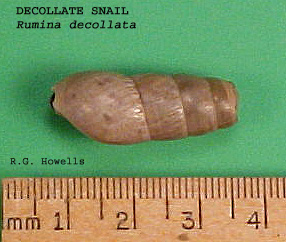Rumina decollata
Decollate Snail
Synonym(s):
Class: Gastropoda
Order: Stylommatophora
Family: Subulinidae

Photographer: R. G. Howells
Source: Texas Park and Wildlife
Description
The decollate snail (Rumina decollata) is an inch long terrestrial snail that is uniformly tan to light brown in color. It is common for adults to have the tip of their coiled shell broken off (decollated).
Ecological Threat: Decollate snails are omnivorous and thus can be harmful or helpful to garden landscapes. As a predator, the decollate snail is useful with the control of the herbivorous brown garden snail. However, the decolallate snail is also herbivorous, and if there are no brown garden snails or other alternatives the decollate snail can cause serious damage to landscape plants.
Biology: Eggs of decollate snails are laid in masses under piles of debris or in the soil. The eggs typically hatch within a month after they are laid if conditions are favorable. The resistant nature of the 1 inch eggs allows for longer periods of incubation if the environment is not suitable.
History: Introduction of the decollate snail was intended for use as a biological control of the brown garden snail (Cornu aspersum). The snail was first introduced in the 1800's in Charleston, SC.
Article: The Snail Destroyer - Growquest Nursery
Habitat: Decollate snails are commonly found in landscape plants where they feed on other snails and slugs or vegetation.
Distribution
Native Origin: Mediterranean region
U.S. Present: Throughout the U.S., but highly concentrated in the southern states from California to Pennsylvania
Texas: Austin, Abilene, Dallas, San Antonio, Guadalupe river, and San Angelo
Management
Decollate snails can easily be removed using a combination of methods involving habitat modification, hand picking, trapping, barriers, and bait. Modifying habitats can help prevent any kind of pest snail through removal of hiding places such as clumps of vegetation or piles of brush.
References
Fisher TW, Orth RE, Swanson SC. 1980. Snail against snail. California Agriculture Nov.-Dec.: 3 pp.
Pilsbry HA. 1946. Land Mollusca of North America (North of Mexico). Academy of Natural Sciences Philadelphia Monographs No. 3, 2:1-520.
Internet Sources:
http://insects.tamu.edu/extension/publications/epubs/eee_00026.cfm
Back to Invasive Mollusks and Crustaceans
Snail against snail.
 Texas Invasive Species Institute
Texas Invasive Species Institute